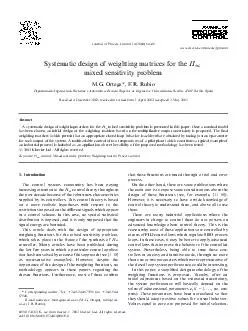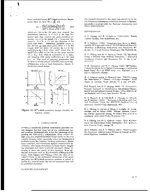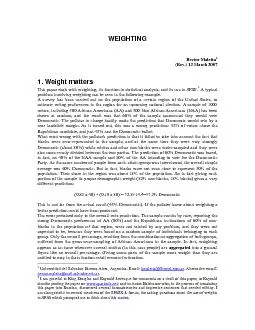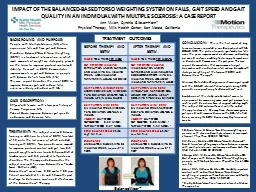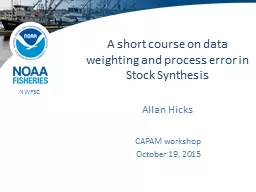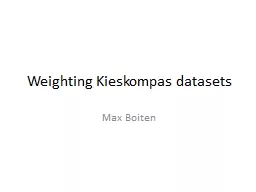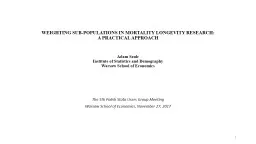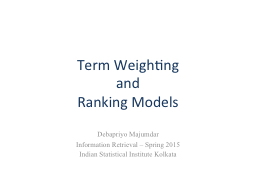PPT-Term Weighting
Author : min-jolicoeur | Published Date : 2017-10-26
and Ranking Models Debapriyo Majumdar Information Retrieval Spring 2015 Indian Statistical Institute Kolkata Parametric and zone indexes Thus far a doc has been
Presentation Embed Code
Download Presentation
Download Presentation The PPT/PDF document "Term Weighting" is the property of its rightful owner. Permission is granted to download and print the materials on this website for personal, non-commercial use only, and to display it on your personal computer provided you do not modify the materials and that you retain all copyright notices contained in the materials. By downloading content from our website, you accept the terms of this agreement.
Term Weighting: Transcript
and Ranking Models Debapriyo Majumdar Information Retrieval Spring 2015 Indian Statistical Institute Kolkata Parametric and zone indexes Thus far a doc has been a sequence of terms In fact documents have multiple parts some with special semantics. Amir Ghoreishi Mohammad A li Nekoui S Omid Basiri International Journal of Intelligent Information Processing Volume 2 Number 1 March 2011 Optimal Design of LQR Weightin g Matrices based on Intelligent Optimization Methods SAmir Ghoreishi Mohammad Al G Ortega FR Rubio Departamento Ingenier a de Sistemas y Automa tica Escuela Superior de Ingenieros Universidad de Sevilla 41092Sevilla Spain Received 4December 2002 received in revised form pril 2003 accepted 2 May 2003 Abstract systematic design Theory and Weighting Strategies of Mixed Sensitivity Hm Synthesis on a Class of Aerospace Applications Richard Y Chiang and Red Y Hadaegh Jet P7sopulsion Iaboraiory California lnstituic oj Yhchnology Abstract T Autonomy etalks Q64257niti Advise meets those needs Q64257niti Advise is a centralized evaluation and analysis solu tion that drives contact center performance by enhancing coaching and eLearning effectiveness streamlining quality management tasks a Information Systems Project Management. Present By: . MD.Shojib. . Mahabub. Student ID. : . 107228. Tallinn University of Technology. Product Backlog. Product backlog is a high level list maintained in a project . . 2. Weighting cases and weighting variables A data set is usually composed of cases for which several are predicated. Thus the data set is a rectangular array of cases by variables. Statistical analys Ann Vivian, Cynthia Gibson-Horn* . Physical Therapy, Mills Health Center, San Mateo, California . TREATMENT OUTCOMES. BACKGROUND AND PURPOSE: . People with Multiple Sclerosis (MS) often experience falls and have gait and balance disorders. Stock Synthesis. Allan Hicks. CAPAM workshop. October 19, 2015. Working definitions. Process error. Variability of a process (time-varying). e. .g., recruitment or selectivity. Data weighting. Balancing data sources such that the expected variability matches input variability. Kieskompas. datasets. Max . Boiten. Overview. Weighting. . methodologies. Sampling . from. data. Weighting. data. Sampling . from. . data. Sample matching. Take . probability. sample. Match cases . ERHS 630. . Radiation and Tissue. Weighting Factors. Environmental and Radiological Health Sciences. System of Quantities. . Dosimetric. quantities for external radiation (from ICRP 74 / ICRU 57). Ranked retrieval. Thus far, our queries have all been Boolean.. Documents either match or . don’t. .. Good for expert users with precise understanding of their needs and the collection.. Also good for applications: Applications can easily consume 1000s of results.. Bureau Chief, Public Health Statistics. Division of Public Health Preparedness. Judy Bass. Arizona’s BRFSS Coordinator . June 26, 2012. What are we covering and what we are not?. We are talking about BRFSS and changes in methods.. LONGEV. ITY . RESEARCH. :. A . PRACTICAL APPROACH. . . Adam . Szulc. Institute of Statistics and Demography. Warsaw School of Economics. The 5th Polish Stata Users Group Meeting. Warsaw School of Economics, November 27, 2017. Debapriyo Majumdar. Information Retrieval – Spring 2015. Indian Statistical Institute Kolkata. Parametric and zone indexes. Thus far, a doc has been a sequence of terms. In fact documents have multiple parts, some with special semantics:.
Download Document
Here is the link to download the presentation.
"Term Weighting"The content belongs to its owner. You may download and print it for personal use, without modification, and keep all copyright notices. By downloading, you agree to these terms.
Related Documents


